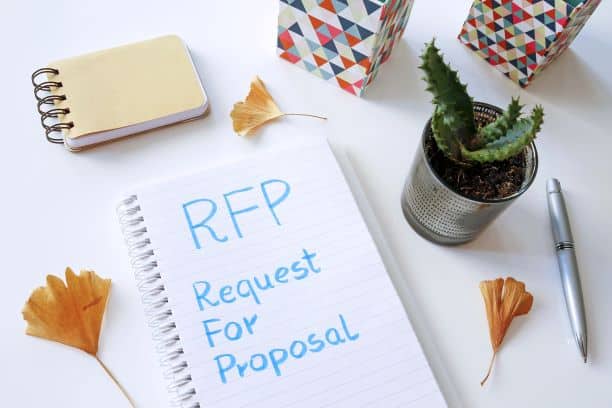A Proven RFP Process For Any Company

The ultimate step-by step guide to a successful request for proposal
What is a Request For Proposal (RFP)?
A request for proposal (sometimes referred to as a request for pricing), or RFP, is usually a document that describes a companies needs (usually goods and/or services). Typically it will consist of a list of the goods and services that they need to purchase from a supplier. A company will then send this to a number of suppliers to get pricing, obtain timelines and get answers to any questions they might have. The RFP process acts as a critical process that can help companies to procure goods and services, ensure they are delivered in a timely manner and that they know more about the suppliers they are working with.
The RFP process can often be made complex and time-consuming however it is much simpler than you might think We have detailed below how you can take the right approach when creating an RFP from scratch with a detailed a step-by-step proven process for success and speed.
A request for proposal (RFP) is a business document that announces a project, describes it, and solicits bids from qualified contractors to complete it. Most organizations prefer to launch their projects using RFPs, and many governments always use them.
When using an RFP, the entity requesting the bids is responsible for evaluating the feasibility of the bids submitted, the financial health of the bidding companies, and each bidder’s ability to undertake the project.
What’s the purpose of the RFP Process? When should you use an RFP?
Before making a start you need to understand if an RFP process is the right one for you. We have detailed three main justifications for creating and sending an RFP to your supplier(s).
- To find a new or better supplier for your company’s needs. RFP’s should not be created too often and especially not for every purchase. If your company already has a preferred supplier in place then you need to ask the question ‘Do I need to create a new RFP?’. Suppliers you already use and know well might already be able to offer the goods and services you require. Find out more about supplier management. However, if you are looking for more competitive pricing, your current provider’s contract is about to end, or need to procure a specific good or service then an RFP is probably the correct path.
- Fairness. The RFP process should be standardised for all suppliers involved (e.g. they all receive the same documents to complete and the same timeline to respond in) and therefore offers a fair playing field and transparency when you come to evaluate RFP responses. This is a great justification for creating an RFP as it means that you can compare suppliers side-by-side based on the responses that they have given.
- Supplier vetting and due diligence. The process of an RFP offers an opportunity to get to know your potential new supplier. An RFP is not all about the best possible price, in fact, that is where a lot of companies go wrong. An RFP is an opportunity to ask a supplier to cost up requested goods or services as well as a key period to get to know them better. You should also create a questionnaire for them to complete to ensure that they fit your companies needs and vetting criteria (e.g. What insurances do you have in place?) and also use this opportunity to find out if they stand out from others involved in your RFP process (e.g. ‘Do you have a rebate scheme?’). Later when comparing your suppliers, answers to these questions might make one supplier stand out from the rest.
Once you have decided to run an RFP you will need to work out the best way to run it in an organised and fair manner. There are two main options for you to choose from:
- Digital format – eProcurement software’s should offer an ‘eSourcing platform‘ which will allow you to run an RFP process end-to-end including the supplier evaluation stage. The huge upside to running a digital RFP is that it makes it standardised for your suppliers and yourself when evaluating them after they’ve responded. It also means that you do not need to worry about losing emails or documents from the suppliers involved as they are all stored in the system. Be careful though, some of these can be extremely expensive as they are aimed at enterprise size organisations however with newer cloud eProcurement software coming to the market, you should be able to find a cost-effective one for your needs. Check out our blog on how to select the right eProcurement software for your company. You can even try oboloo free for 30 days.
- Traditional format – As mentioned above, this is often done by creating an Excel spreadsheet of all the goods and services you would like your suppliers to price against and is send via email. The cons to this format are that you run the possibility of losing supplier’s responses or your original email ending up in their junk folder. Another is that suppliers try to go above and beyond to stand out when responding to an RFP and will alter the spreadsheet to fit more information in. This does not work well when you’re trying to compare them against each other at the evaluation stage. And finally, you will have to merge all of their responses (which are often in different formats) into one spreadsheet for comparison so if this is your preferred method please allow time for this as you will most likely find that you will need to ask a supplier or two to resubmit their response to fit in with your master spreadsheet or you will even end up having to do this yourself which is a very big task.
Depending on what you are trying to procure from a supplier is key when evaluating the above two processes for an RFP. If you are procuring a single ‘good’ and asking two suppliers for their prices then a traditional way might not be so bad, however, if you are wanting pricing for multiple goods or service’s from more than two suppliers then you need to think about the time it takes to write and distribute a good RFP and collate the responses. Issuing a procurement document for office suppliers (pencils and pens) can be thousands of product lines that a supplier needs to fill in, and therefore thousands of product prices that you will need to analyse and evaluate. Digital platforms will do this work for you, and instantly.
What are the standard steps in the RFP Process & the RFP preparation process?
You may not need to use every step of the below RFP process however they should still be considered.
- Establish the companies needs. This is one of the most important and obvious parts of any RFP. Before you start creating your RFP process you need to think about what the entire company actually needs from it. Communication to all the different stakeholders involved or affected locations and departments is vital in order to gather all of their requirements and to measure any potential impact of changing suppliers. E.g. is there already a contract in place? Is another area of the business still using this supplier for critical work? Should another department have some input? Will there be disruption to the business for any amount of time? This is a key area of the strategic procurement process.
- Define your overall budget
- Choose suppliers to invite. This point for some can be a quick and easy one (simply finding ten suppliers that they think can deliver what is needed and sending the RFP to a generic company email address). However, think about this carefully as it could save time and money in the long run. It is worthwhile getting to know your suppliers beforehand, having a meeting with them to discover their capabilities, ensuring that they will meet any future vetting process, and to spot any potential red flags. The supplier management process starts here and should not be underestimated.
- Create an RFP (See below section for more details)
- Create your scoring criteria and values. Companies will usually do this after they’ve sent the RFP to their selected suppliers. We would advise to always create them beforehand. This is because it is always important to know what you’re planning on scoring the supplier’s responses against and what is important to your company and the internal stakeholders whilst you’re creating the RFP. Often scoring criteria is a weighted calculation to reflect your priorities. E.g. you might have 10 areas to score on however one of these areas might account for 30% of the overall score if that is an area your company strongly cares about.
- Send the RFP. Depending on what route you decided to take (digital or traditional) you can now send your RFP to your suppliers. This should usually consist of multiple documents or sections. Firstly the main RFP document (an overview of what you’re trying to achieve, key dates such as the submission deadline, questions from the supplier’s deadline and contact information), a questionnaire (best practice is to make this as standardised as possible for easy evaluation later on) and an overview of the scoring criteria you are planning to use for the evaluation (this allows suppliers to answer more specifically to your needs).
- Answer supplier questions. RFP’s are never 100% straightforward and every company interprets them differently from the next. As mentioned in point 6, it is important to allow suppliers an opportunity to send you a list of questions that they might have and for you to respond in as greater detail as possible. Remember to give them a deadline to send these questions to yourselves and to give them enough time to respond to the RFP once they have received your answers.
- Review responses. If you choose to carry out your RFP on a digital platform then this is the easy part. The procurement system will do this for you automatically and compare your supplier’s costings and questionnaire responses side by side. If you choose the traditional method then you will most likely need to consolidate each supplier’s response into a centralised spreadsheet and perform a number of calculations as well as validation to ensure that there are no mistakes in any of the supplier’s responses. Once the analysis is complete, it is important to include all of the internal stakeholders involved (point 1) to present the results to. This is also an opportunity to get other areas of the business involved such as Commercial, to review a supplier’s Scope of Works or Finance to look over the supplier’s costings.
- Score the responses and select a supplier.<span< a=””> style=”color: #666699;”> By this stage, you might decide it is worthwhile removing some of the suppliers that you believe would not be a good fit for whatever reason. Information on </span<>supplier short-listing can be found here. Narrowing down the number of suppliers to perhaps the top 3 will help at this stage. You can now use the scoring criteria you created earlier on in the RFP process to score each supplier based on the responses they submitted. You should not notify any suppliers that you believe have been unsuccessful yet.
- Negotiate and sign a contract. You should now take time to meet the supplier to discuss the expectations from them and the contract. The RFP is not a legal contract and both parties now have the opportunity to negotiate and reach a final agreement based on the details within the RFP (make sure you include your Legal and Commercial departments). Once agreed and signed you should now notify the unsuccessful supplier’s within the RFP process. This is done at the very last stage just in case an agreement with the initial supplier should not be reached.
What information should you include in your RFP?
RFP templates off of the internet are available and can be a good starting point however will very rarely meet your company’s needs. Ensure that information is correct such as dates and contact info. Cloud-based procurement software will build the RFP for you automatically. Although each RFP is unique, most will contain the majority of the following sections:
- Your company background & general information
- Project description – what you are trying to achieve from this RFP process
- Project requirements and project objectives: This is often the lengthiest section of the RFP. Be specific.
- Scoring Criteria- This doesn’t need to go into detail about how you plan to score your suppliers, just a simple table listing your scoring criteria and the weighted scoring % against each one.
- Milestones and deadlines – including a deadline for suppliers to submit any questions.
- Questionnaire – Remember, an RFP is not just about cost but also about other critical areas a supplier can fulfill. A questionnaire can be used later on when scoring suppliers against your criteria and values. E.g. if you care about sustainability as a company you can ask them if they have a sustainability policy and if so can they attach this to their response.
- Contact information and the deadline for submissions (again).
How should you score and evaluate RFP responses?
As mentioned above, creating scoring criteria while creating your RFP will save you time in the long run and is seen as best practice. This is the time you will want to include your internal stakeholders from the business to give them final input and say on the supplier selection process. If you have done a digital RFP then this can be carried out on the procurement platform however if you have done a traditional method then this will have to be done manually via the creation of a scorecard. An example can be found here. Assign a score against each of your scoring criteria for each of your suppliers. You should put in a calculation if you are doing this via a manual spreadsheet if you’re using a weighted method. E.g. if you give ‘Supplier A’ a score of 3 for the criteria of ‘Sustainability’ on a scale of 1 to 10 and you’ve given that criteria a 30 percent weighting, you should assign this vendor 9 points. You can ask more than one person to score which you can then work out an average per supplier. Usually, the supplier with the highest score at the end should be awarded the contract.
Additional resources
These external articles contain useful points to consider when creating an RFP:

